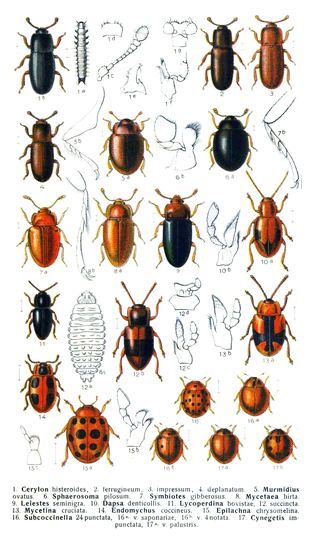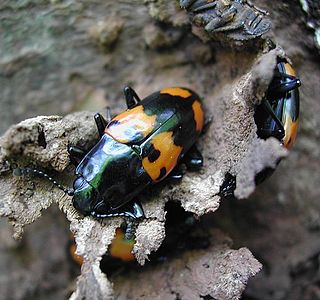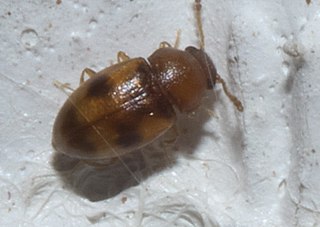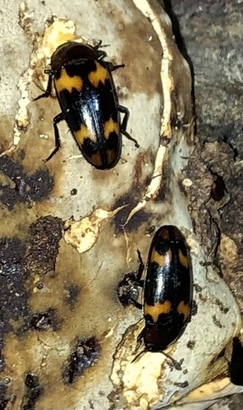
Cucujoidea is a superfamily of beetles. This group formerly included all of the families now included in the superfamily Coccinelloidea. They include some fungus beetles and a diversity of lineages of "bark beetles" unrelated to the "true" bark beetles (Scolytinae), which are weevils.

Tritoma is a genus of beetles in the family Erotylidae, the pleasing fungus beetles. It is distributed worldwide, mainly in the Old World. There are over 100 species.

Erotylidae, or the pleasing fungus beetles, is a family of beetles belonging to Cucujoidea containing over 100 genera. In the present circumscription, it contains 6 tribes and 10 subfamilies. In other words, the narrowly circumscribed Erotylidae correspond to the subfamily Erotylinae in the definition sensu lato. There are doubts on the monophyly of lower ranked taxa within Erotylidae, with further phylogenetic studies requiring better sampling and studies of unexplored character sets, for example the metendosternite and penile flagellum, which are generally lacking detailed morphological studies within the Coleoptera literature. The Eroytlina taxonomy is based on traits such as their different colors and not off morphological differences like mouthparts, thorax, and abdominal terminalia (Pecci-Maddalena).

Megalodacne is a genus of fungivorous beetles in the family Erotylidae.

Russula crustosa, commonly known as the crusty russula, is a species of fungus in the family Russulaceae. It is found in Asia and North America.
Ischyrus dunedinensis, the three-spotted pleasing fungus beetle, is a species of pleasing fungus beetle in the family Erotylidae. It is found in North America.

Ischyrus is a genus of pleasing fungus beetles in the family Erotylidae. There are at least three described species in Ischyrus.

Tritomini is a tribe of pleasing fungus beetles in the family Erotylidae. There are about 7 genera and at least 30 described species in Tritomini.

Toramus pulchellus is a species of pleasing fungus beetle in the family Erotylidae. Yellow-brown to dark colored, it is only 1.3mm to 1.6mm long. It is found in North America.

Xenoscelinae is a subfamily of pleasing fungus beetles in the family Erotylidae. There are about 8 genera and 12 described species in Xenoscelinae.

Megalodacne fasciata is a species of pleasing fungus beetle in the family Erotylidae. It is found in North America.
Hirsutotriplax is a genus of pleasing fungus beetles in the family Erotylidae. There is one described species in Hirsutotriplax, H. mcclevei.
Haematochiton is a genus of pleasing fungus beetles in the family Erotylidae. There are at least three described species in Haematochiton.

Cryptophilus is a genus of pleasing fungus beetles in the family Erotylidae. There are about nine described species in Cryptophilus.
Tritoma pulchra, the handsome tritoma, is a species of pleasing fungus beetle in the family Erotylidae. It is found in North America.

Cypherotylus is a genus of pleasing fungus beetles in the family Erotylidae. There are over 30 described species in Cypherotylus. It frequently appears in the literature under the name "Gibbifer", but this name is permanently unavailable under ICZN Article 11.4, as are all of Voet's names.
Tritoma biguttata is a species of pleasing fungus beetle in the family Erotylidae. It is found in North America.

Mycotretus is a genus of pleasing fungus beetles in the family Erotylidae. Mycotretus is the largest genus in the family Erotylidae with at least 204 different species:

Megalodacne grandipennis is a species of pleasing fungus beetle, in the family Erotylidae. It is endemic to Tanzania and Namibia. As is typical of species in the genus Megalodacne, M. grandipennis feeds on bracket fungi.
Megalodacne varia is a species of pleasing fungus beetle in the family Erotylidae. It is endemic to Malaysia. M. varia was discovered by Henry Stephen Gorham in 1889. Like all species of Megalodacne, M. varia feeds on bracket fungi.















